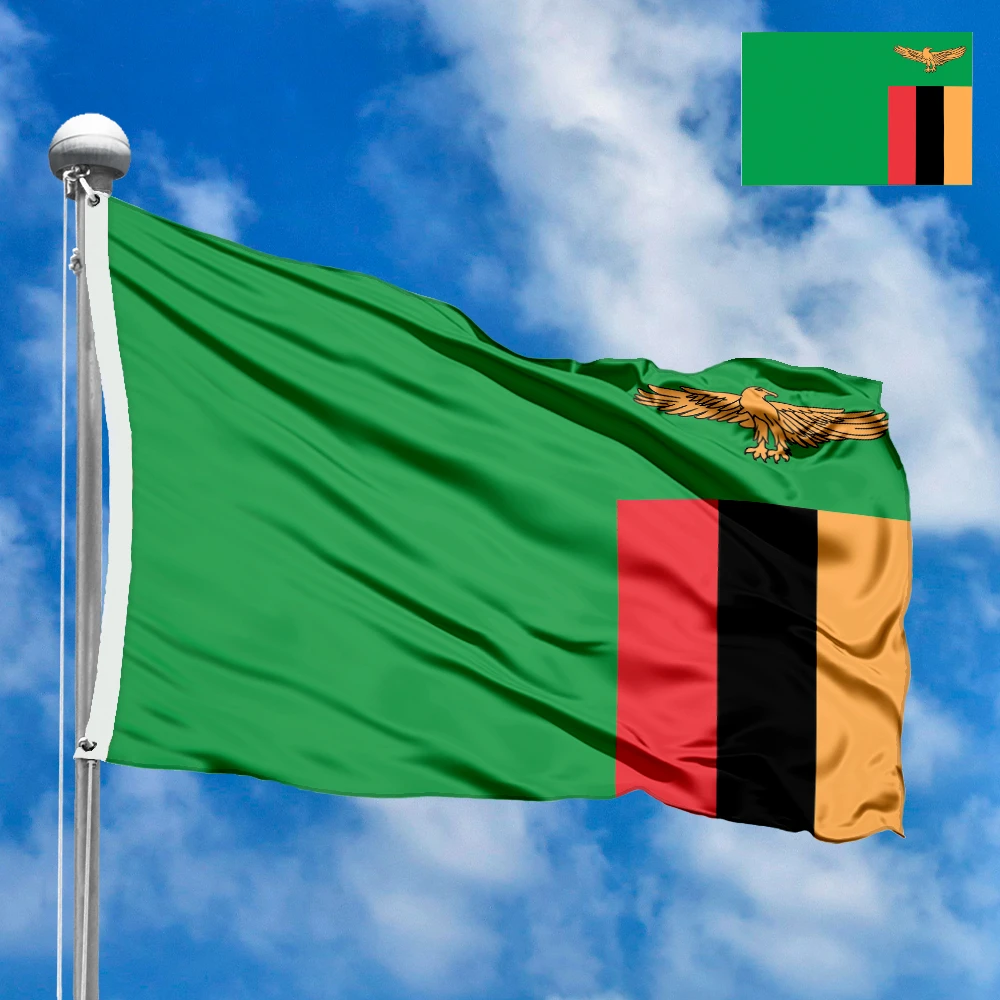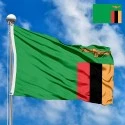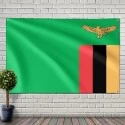The national flag of Zambia is a distinctive and vibrant emblem that beautifully encapsulates the nation's rich natural heritage, its struggle for independence, and its aspirations for progress and peace. Adopted on October 24, 1964, the day Zambia gained its independence from British colonial rule, the flag serves as a powerful visual representation of the country's identity, its resources, and the values held dear by its people. Every element within its design carries profound symbolic weight, reflecting the journey from Northern Rhodesia to Zambia and the dawn of a new, self-determined era.
Design and Symbolism: A Visual Narrative of Zambia
The flag of Zambia features a striking green field with an orange-red aquila (fish eagle) in flight over three vertical stripes of red, black, and orange (from left to right) in the lower fly corner. This unique arrangement and choice of colors are imbued with deep meaning:
-
Green Field: The dominant green background of the flag symbolizes Zambia's rich natural resources and its abundant vegetation. Zambia is blessed with vast forests, fertile lands, and a diverse ecosystem. This color represents the nation's agricultural wealth, its lush landscapes, and the vital role that nature plays in the lives and livelihoods of its people. It signifies growth, vitality, and the connection to the land.
-
Orange-Red Aquila (Fish Eagle): Positioned prominently in the upper fly (top right) corner, the orange-red fish eagle in flight is the most distinctive and dynamic element of the flag. This powerful bird is indigenous to Zambia and holds multiple layers of symbolism:
-
Freedom and the Nation's Ability to Rise Above Problems: The eagle in flight represents the nation's freedom and its capacity to overcome challenges. It embodies the aspirations of the Zambian people to rise above their colonial past and build a prosperous future. It signifies their ability to face and conquer difficulties, soaring to new heights.
-
The People of Zambia: The eagle also represents the people of Zambia themselves, their resilience, and their aspirations for a brighter future.
-
Spirit and Vigilance: It symbolizes vigilance, the spirit of the Zambian people, and their ability to protect their nation.
-
Orange-Red Color: The specific orange-red hue of the eagle is often interpreted as representing Zambia's copper wealth, a crucial mineral resource that has historically been a backbone of the country's economy. It also alludes to the rising sun, signifying a new dawn for the nation.
-
Three Vertical Stripes (Lower Fly Corner): In the lower fly (bottom right) corner, three narrow vertical stripes stand out against the green background. From left to right (from the hoist towards the fly), these stripes are:
-
Red Stripe: The red stripe symbolizes the struggle for freedom and the blood shed by the heroes of the independence movement. It is a solemn tribute to those who sacrificed their lives for Zambia's liberation from colonial rule. It represents courage, sacrifice, and the passion of the Zambian people.
-
Black Stripe: The black stripe represents the people of Zambia themselves, particularly the indigenous African population. It signifies their unity, their strength, and their rightful place as the sovereign inhabitants of the nation. It asserts the identity of the black majority.
-
Orange Stripe: The orange stripe (or sometimes interpreted as gold/amber) represents Zambia's mineral wealth, particularly copper, which is the country's most significant export and a cornerstone of its economy. It also signifies the country's future prosperity and natural resources, especially the mineral wealth, and the country's bright future. Some interpretations connect it to the sun and the dawn of a new era.
The combination of these elements forms a coherent visual story: Zambia (black people) fought for its freedom (red), rooted in its rich land (green) and mineral wealth (orange), and now, as an independent nation, it soars with the spirit of liberty and progress (eagle).
Dimensions and Proportions:
The official proportions of the Flag of Zambia are a width-to-length ratio of 2:3. This is a common and practical ratio for many national flags. The green field covers the vast majority of the flag's area. The three vertical stripes in the lower fly corner are of equal width, and together they occupy approximately one-quarter of the flag's length and extend from the bottom edge of the flag upwards, but not reaching the top edge, leaving space for the eagle above them. The fish eagle is positioned dynamically in the upper right quadrant, sized to be prominent without overwhelming the other elements. Precise guidelines ensure that the eagle's depiction and placement are consistent across all official flags.
History and Evolution: From Northern Rhodesia to Zambia
The history of the Zambian flag is intrinsically linked to the nation's journey from colonial subjugation to self-governance.
-
Colonial Period (Northern Rhodesia): Prior to 1964, the territory known today as Zambia was a British protectorate called Northern Rhodesia. During this period, the flags used were characteristic of British colonial rule:
-
British South Africa Company Flag: From 1891 to 1924, the territory was administered by the British South Africa Company (BSAC), which used its company flag, typically a Union Jack with the BSAC badge.
-
Northern Rhodesia Blue Ensign (1924-1953): When it became a British Protectorate in 1924, Northern Rhodesia adopted a Blue Ensign with the Union Jack in the canton and a badge depicting an eagle standing on a fish, representing the country's copper wealth and natural environment. This early eagle emblem foreshadowed the later national symbol.
-
Federation of Rhodesia and Nyasaland (1953-1963): Northern Rhodesia was part of the Federation of Rhodesia and Nyasaland. During this period, a common federal flag was used, which was a Blue Ensign with a badge representing the three constituent territories (Northern Rhodesia, Southern Rhodesia, and Nyasaland). The badge for Northern Rhodesia within this federal flag still featured the eagle and fish.
-
Northern Rhodesia Blue Ensign (1963-1964): After the dissolution of the Federation, Northern Rhodesia briefly reverted to a modified Blue Ensign, featuring the eagle and fish badge on a lighter blue field, before achieving full independence.
-
Birth of Independent Zambia (1964): The political landscape in Northern Rhodesia was dominated by nationalist movements advocating for independence, most notably the United National Independence Party (UNIP) led by Kenneth Kaunda. After a period of negotiations and a growing demand for self-rule, Zambia achieved full independence on October 24, 1964. On this historic day, the new national flag of Zambia was officially adopted and first hoisted. The design was a deliberate break from colonial symbols, incorporating colors and emblems that directly represented the aspirations and identity of the newly independent African nation. It represented a comprehensive redefinition of the nation's identity, emphasizing its natural beauty, the sacrifices made for freedom, the strength of its people, and its economic potential.
The designer of the flag was Gabriel Ellison, a distinguished Zambian artist and civil servant, who was also responsible for the coat of arms and various other national symbols. Her design successfully captured the essence of Zambia's transition to a sovereign state.
Regional Context and Southern African Identity:
Zambia is a landlocked country strategically located in Southern Africa, bordering several other nations in the region. Its flag, while distinctly Zambian, shares some thematic commonalities with flags of other African nations, particularly those that gained independence through liberation struggles. The use of red, black, and green are common Pan-African colors, often symbolizing similar concepts across the continent: green for land/agriculture/natural resources, red for the blood shed during liberation, and black for the indigenous people.
However, Zambia's flag is unique in its dynamic layout and the prominence of the fish eagle. Unlike many flags that feature simple horizontal or vertical stripes, the Zambian flag uses a unique arrangement of its stripes in the lower fly and positions the eagle in a way that suggests upward movement and freedom. This distinctiveness sets it apart even while its colors resonate with a shared African identity. The flag thus balances its place within the broader African context with a strong assertion of its unique national character, reflecting its specific historical trajectory and its aspirations within the Southern African region. It is a symbol of a sovereign nation, deeply proud of its heritage and its hard-won freedom, engaging with and influencing the regional dynamics of southern Africa.
Interesting Facts:
-
Unique Design Arrangement: The Zambian flag is one of the few national flags where the symbolic elements (the three vertical stripes and the eagle) are placed entirely within the fly half (the half furthest from the flagpole) of the flag, rather than being centered or spread across the entire field.
-
The Aquila's Identity: The specific species of eagle depicted is the African Fish Eagle (Haliaeetus vocifer), a majestic bird found widely across sub-Saharan Africa, known for its distinctive cry. Its inclusion emphasizes the natural heritage and unique wildlife of Zambia.
-
Symbolic Continuity: The use of an eagle on the flag has a precedent in the colonial Northern Rhodesian flag, which also featured an eagle, albeit in a different context (standing on a fish). This shows a subtle, perhaps unintentional, continuity in the symbolism of the land.
-
Designer's Legacy: The flag was designed by Gabriel Ellison, an accomplished artist whose work left a lasting mark on Zambia's national identity.
-
Pan-African Colors with a Twist: While incorporating traditional Pan-African colors (green, black, red), the addition of orange and their specific placement make the Zambian flag distinct from other African flags that use similar palettes. The orange specifically highlights the copper industry.
-
Significance of Copper: The orange in the stripes and the orange-red of the eagle strongly emphasize copper, underscoring its historical and ongoing economic importance to Zambia.
-
Adopted on Independence Day: The flag's adoption on October 24, 1964, directly tied its creation to the birth of the independent nation, making it an immediate and powerful symbol of national sovereignty.
-
No Central Emblem: Unlike many flags with a central emblem or coat of arms, the Zambian flag uses a dynamic arrangement of elements off-center, contributing to its unique aesthetic.
-
Official Proportions: The 2:3 ratio is relatively standard, but the internal proportions and placement of the elements are what truly define its unique visual identity.
-
Representation of Diverse Elements: The flag effectively condenses symbols of nature, human struggle, economic wealth, and national aspiration into a single, cohesive design.
Significance for the Inhabitants: A Banner of Identity, Pride, and Future
For the people of Zambia, their national flag is far more than just a piece of fabric; it is a profound and deeply cherished emblem that encapsulates their arduous journey from colonial rule to self-determination, their inherent pride in their land, and their collective aspirations for a prosperous future. It is a visual testament to who they are, where they come from, and where they are heading.
The expansive green field that forms the backdrop of the flag immediately resonates with Zambians' deep connection to their environment. It evokes images of the vast, fertile lands that sustain them, the lush forests that provide resources, and the rich biodiversity that is an integral part of their heritage. This green signifies growth, life, and the promise of agricultural abundance, a vital aspect of their economy and daily existence. It reminds them of the natural beauty and wealth that define their nation.
The three vertical stripes in the lower fly corner tell a powerful story of sacrifice and identity. The vibrant red stripe serves as a solemn and perpetual reminder of the blood shed and the lives lost during the bitter struggle for independence from British rule. It honors the bravery and unwavering resolve of the freedom fighters, fostering a deep sense of gratitude and respect for their ancestors' sacrifices. The black stripe proudly represents the indigenous people of Zambia – their unity, resilience, and their rightful sovereignty over their land. It reinforces a strong sense of collective identity and belonging, asserting their place as the rightful owners of their destiny. The orange stripe, often interpreted as symbolizing Zambia's immense mineral wealth, particularly copper, is a constant reminder of the economic backbone of the nation. It speaks to the potential for prosperity and development, fueling hopes for a better standard of living for all citizens.
Above these stripes, soaring dynamically, is the majestic orange-red African Fish Eagle. This powerful bird is not just an emblem but a living representation of the Zambian spirit. It symbolizes the nation's hard-won freedom, its ability to rise above adversity, and its unwavering optimism for the future. The eagle's flight suggests progress, vision, and the capacity to overcome challenges, inspiring Zambians to strive for greater heights in all aspects of life. Its color, often linking back to copper, further ties it to the nation's economic strength and potential.
The adoption of this flag on October 24, 1964, was a watershed moment, marking the formal birth of independent Zambia. For those who witnessed this historic event, the raising of the flag was an emotionally charged experience, signifying the end of an era of oppression and the dawn of self-rule. For subsequent generations, the flag serves as a continuous educational tool and a source of profound pride. It is displayed prominently during national holidays, sporting events, and cultural celebrations, uniting people from diverse backgrounds under a common banner. It transcends tribal and political affiliations, embodying the shared history, collective struggles, and common aspirations of all Zambians. It is a living symbol of their sovereignty, their identity, and their enduring hope for peace, unity, and prosperity.
In the demonstration images, full-size flags are shown with proportions of 2:3, and hand-held flags with proportions of 1:2.






 Waving flag
Waving flag
 Sizes:
Sizes:
 Round flag
Round flag
 Sizes:
Sizes:
 Rectangular flag 2:3
Rectangular flag 2:3
 Sizes:
Sizes: